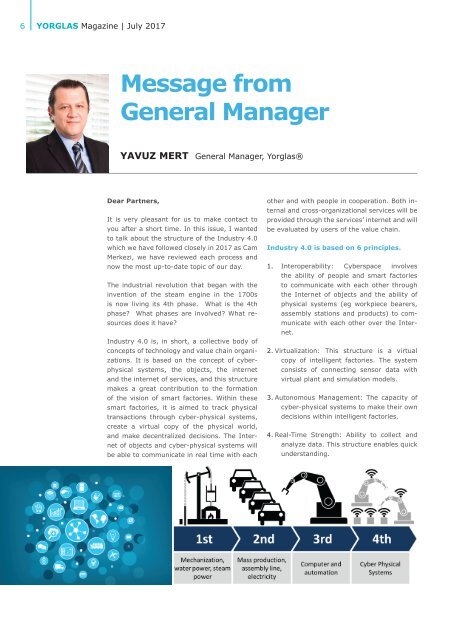Create successful ePaper yourself
Turn your PDF publications into a flip-book with our unique Google optimized e-Paper software.
6<br />
YORGLAS Magazine | July <strong>2017</strong><br />
Message from<br />
General Manager<br />
YAVUZ MERT General Manager, Yorglas®<br />
Dear Partners,<br />
It is very pleasant for us to make contact to<br />
you after a short time. In this issue, I wanted<br />
to talk about the structure of the Industry 4.0<br />
which we have followed closely in <strong>2017</strong> as Cam<br />
Merkezi, we have reviewed each process and<br />
now the most up-to-date topic of our day.<br />
The industrial revolution that began with the<br />
invention of the steam engine in the 1700s<br />
is now living its 4th phase. What is the 4th<br />
phase? What phases are involved? What resources<br />
does it have?<br />
Industry 4.0 is, in short, a collective body of<br />
concepts of technology and value chain organizations.<br />
It is based on the concept of cyberphysical<br />
systems, the objects, the internet<br />
and the internet of services, and this structure<br />
makes a great contribution to the formation<br />
of the vision of smart factories. Within these<br />
smart factories, it is aimed to track physical<br />
transactions through cyber-physical systems,<br />
create a virtual copy of the physical world,<br />
and make decentralized decisions. The Internet<br />
of objects and cyber-physical systems will<br />
be able to communicate in real time with each<br />
other and with people in cooperation. Both internal<br />
and cross-organizational services will be<br />
provided through the services’ internet and will<br />
be evaluated by users of the value chain.<br />
Industry 4.0 is based on 6 principles.<br />
1. Interoperability: Cyberspace involves<br />
the ability of people and smart factories<br />
to communicate with each other through<br />
the Internet of objects and the ability of<br />
physical systems (eg workpiece bearers,<br />
assembly stations and products) to communicate<br />
with each other over the Internet.<br />
2. Virtualization: This structure is a virtual<br />
copy of intelligent factories. The system<br />
consists of connecting sensor data with<br />
virtual plant and simulation models.<br />
3. Autonomous Management: The capacity of<br />
cyber-physical systems to make their own<br />
decisions within intelligent factories.<br />
4. Real-Time Strength: Ability to collect and<br />
analyze data. This structure enables quick<br />
understanding.


